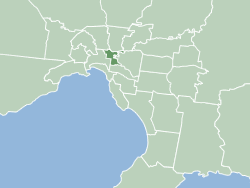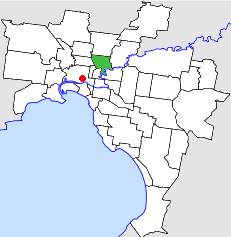
The Yarra River or historically, the Yarra Yarra River, is a perennial river in south-central Victoria, Australia.

The City of Yarra is a local government area (LGA) in Victoria, Australia in the inner eastern and northern suburbs of Melbourne. It is the second smallest LGA in the state with an area of 19.5 square kilometres (7.5 sq mi), and in June 2021 it had a population of 91,543, making it the second most densely populated LGA, with around 4,695 people per square kilometre. The City of Yarra was formed in 1994 as a result of the amalgamation of the former Cities of Richmond, Collingwood, Fitzroy, and parts of Carlton North and parts of Alphington and Fairfield.

The City of Whittlesea is a local government area located in the outer northern suburbs of Melbourne, the state capital of Victoria, Australia. The city covers an area of 490 square kilometres (189.2 sq mi), and in June 2018, it had a population of 223,322.

The City of Darebin is a local government area in Victoria, Australia, in the northern suburbs of Melbourne. It has an area of 54 square kilometres (20.8 sq mi) and in June 2018 Darebin had a population of 161,609. Municipal offices are located at 350 High Street, Preston.

The City of Banyule is a local government area in Victoria, Australia in the north-eastern suburbs of Melbourne. It was created under the Local Government Act 1989 and established in 1994 as an amalgamation of former councils. It has an area of 63 square kilometres (24.3 sq mi) and lies between 7 and 21 km from central Melbourne. In 1994 it had a population of 116,000. In June 2018 Banyule had a population of 130,237. The Yarra River runs along the City's southern border while its western border is defined by Darebin Creek.

Fairfield is a suburb in Melbourne, Victoria, Australia, 6 km (3.7 mi) north-east of Melbourne's Central Business District, located within the Cities of Darebin and Yarra local government areas. Fairfield recorded a population of 6,535 at the 2021 census.

Alphington is a suburb in Melbourne, Victoria, Australia, 7 km (4.3 mi) north-east of Melbourne's Central Business District, located within the Cities of Darebin and Yarra local government areas. Alphington recorded a population of 5,702 at the 2021 census.

Northcote is an inner-city suburb in Melbourne, Victoria, Australia, 7 km (4.3 mi) north-east of Melbourne's Central Business District, located within the City of Darebin local government area. Northcote recorded a population of 25,276 at the 2021 census.

The Hurstbridge Line is a commuter railway line in the city of Melbourne, Victoria, Australia. Operated by Metro Trains Melbourne, it is the city's seventh longest metropolitan railway line at 36.7 kilometres (22.8 mi). The line runs from Flinders Street Station in central Melbourne to Hurstbridge Station in the north-east, serving 28 stations via Clifton Hill Station, Heidelberg Station, Macleod Station, Watsonia Station, Greensborough Station, Eltham Station, and Diamond Creek Station. The line operates for approximately 19 hours a day with 24 hour service available on Friday and Saturday nights. During peak hour, headways of up to 15 minutes are operated with services every 20–30 minutes during off-peak hours. Trains on the Hurstbridge Line run with a two three-car formations of X'Trapolis 100 trainsets.
HM Prison Fairlea was an Australian female prison located on Yarra Bend Road in the suburb of Fairfield, Victoria, Australia. The first all-female prison in Victoria, it was built on the site of the Yarra Bend Asylum, with remnants of the walls and gates being used in the layout of the prison. In 1982 a deliberately lit fire led to the deaths of three inmates. The rebuilt and expanded prison reopened in 1986. After closing in 1996 due to privatisation of sections of the prison system, Fairlea was demolished and the site converted to parkland.

Amcor plc is a global packaging company. It develops and produces flexible packaging, rigid containers, specialty cartons, closures and services for food, beverage, pharmaceutical, medical-device, home and personal-care, and other products.

The Chandler Highway is a short road in the inner eastern suburbs of Melbourne. It runs from Heidelberg Road in Alphington, crosses the Yarra River, then continues across the Eastern Freeway, then terminates at an intersection with Princess Street and Earl Street. Its total length is less than 2 kilometres, leading to the claim that it is "the shortest highway in the world". It was named after a prominent local businessman and politician A. E. Chandler, who was instrumental in pushing through the development of the Outer Circle railway.

Alphington Grammar School is a private, co-educational secondary school located in Alphington, Victoria, Australia, established by the Orthodox Community of Melbourne in 1988.

The City of Northcote was a local government area about 5 kilometres (3 mi) northeast of Melbourne, the state capital of Victoria, Australia. The city covered an area of 17.62 square kilometres (6.80 sq mi), and existed from 1883 until 1994.

The APM Siding was a 1.125-kilometre (0.7 mi) long private railway siding in the suburb of Alphington, Melbourne, Australia, that served the Australian Paper Manufacturers paper mill. The siding branched from Fairfield station, on the Hurstbridge line, and ran south-east, passing through the intersection of Chandler Highway, Grange and Heidelberg Roads, and entering the factory.
Donnybrook is a suburb in Melbourne, Victoria, Australia, 30 km (19 mi) north of Melbourne's Central Business District, located within the City of Whittlesea local government area. Donnybrook recorded a population of 2,100 at the 2021 census.

North Pine Pumping Station is a heritage-listed pumping station at Lake Kurwongbah-Dayboro Road, Whiteside, City of Moreton Bay, Queensland, Australia. It was built from 1956 to 1961 by K D Morris & Sons Pty Ltd. It is also known as Dayboro Road Pumping Station. It was added to the Queensland Heritage Register on 28 January 2009.
George Henry Ward was an Australian rules footballer who played with Essendon in the Victorian Football League (VFL).
William Brookes was a gold miner, pastoralist and paper manufacturer, included in the Australian Dictionary of Biography.

Heidelberg Road is a major arterial road through the north-eastern suburbs of Melbourne. It was the first road in Victoria outside the township of Melbourne. Heidelberg Road was the main route for people travelling to Heidelberg, from the mid to late 1800s.


















